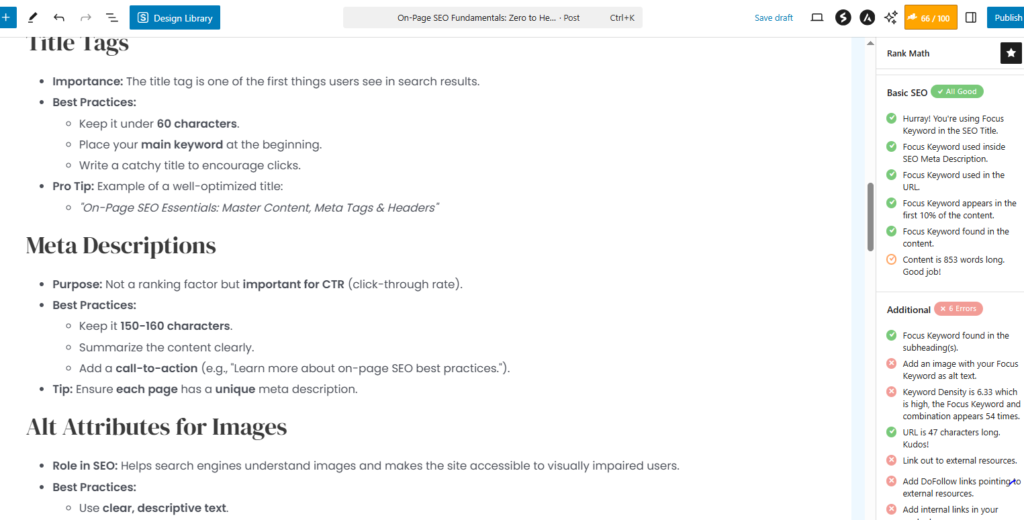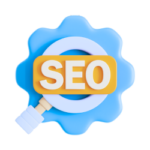In today’s online environment, it is a requirement to have your site appear high on search engines. Optimizing on-page elements is one of the best ways of improving your site’s performance. On-page SEO Fundamentals is all about those elements of your site that you have control over.
This guide covers the fundamental principles—content, meta tags, and headers—why they are significant, how to optimize them, and how they work together to improve your site’s ranking on search engines.
1. Content’s Role in On-Page SEO
Content is the skeleton of every site. It does not just supply value to your visitors; it also gives considerable signals to search engines about what your website is about. Let’s understand why content is vital to on-page SEO:
Quality and Relevance
- User-Centric Strategy: High-quality, valuable content builds trust and keeps users on your page longer.
- Receiving Queries: Well-researched pages answering common questions naturally include keywords users search for.
- Freshness: Regularly posting new content informs search engines that your site is active and relevant.
Structure and Readability
- Clear Organization: Use paragraphs, lists, and graphics to make content easily scannable.
- Engaging Writing: Keep a conversational tone and include examples, case studies, or step-by-step guides.
- Visuals and Media: Use images, infographics, and videos, ensuring they have optimized alt text (discussed in the meta tags section).
Content Optimization Techniques
- Keyword Placement: Position keywords naturally without excessive repetition (avoid keyword stuffing).
- Internal Linking: Direct users to related pages on your website to improve navigation and SEO.
- Content Depth and Length: Longer, comprehensive articles perform well but must provide value, not just word count.

2. Optimizing Meta Tags for Greater Exposure
Meta tags are short summaries of a page’s content, embedded in its code. Search engines use them to understand what a page is about.
Title Tags
- Importance: The title tag is one of the first things users see in search results.
- Best Practices:
- Keep it under 60 characters.
- Place your main keyword at the beginning.
- Write a catchy title to encourage clicks.
- Pro Tip: Example of a well-optimized title:
- “On-Page SEO Essentials: Master Content, Meta Tags & Headers”
Meta Descriptions
- Purpose: Not a ranking factor but important for CTR (click-through rate).
- Best Practices:
- Keep it 150-160 characters.
- Summarize the content clearly.
- Add a call-to-action (e.g., “Learn more about on-page SEO best practices.”).
- Tip: Ensure each page has a unique meta description.
Alt Attributes for Images
- Role in SEO: Helps search engines understand images and makes the site accessible to visually impaired users.
- Best Practices:
- Use clear, descriptive text.
- Insert keywords naturally.
- Avoid keyword stuffing.
- Example: Alt text for an infographic on content optimization:
- “Infographic explaining key content optimization tips for on-page SEO.”
Other Meta Tags
- Robots Meta Tag: Tells search engines how to crawl and index your page.
- Canonical Tag: Prevents duplicate content issues by specifying the preferred version of a web page.
- Best Practice: Regularly review your meta tags to align with content updates.
3. The Role of Headers in Organizing Your Content
Headers (H1, H2, H3, etc.) break up text, making content more readable for users and easier to index for search engines.
Hierarchy and Organization
- Logical Structure:
- H1: Page title
- H2: Major sections
- H3-H6: Subsections
- Improving Readability: Helps users scan content quickly, reducing bounce rates and improving engagement.
Keyword Use in Headers
- Strategic Placement: Insert keywords naturally in header tags.
- Natural Flow: Ensure clarity and avoid keyword stuffing.
- Example: A blog post on SEO might use:
- H1: “On-Page SEO Basics”
- H2s: “Content Optimization,” “Meta Tags Best Practices,” “Best Practices for Headers”
Visual Appeal and Consistency
- Design & Styling: Headers should be visually distinct and consistently formatted.
- Mobile Optimization: Ensure readability on mobile devices.
4. Content, Meta Tags, and Headers: A Holistic Approach to On-Page SEO Fundamentals
While content, meta tags, and headers work well separately, they are most effective together.
Planning Your Content
- Outline Creation: Use headers to structure content.
- Keyword Research: Integrate primary and secondary keywords naturally.
Writing and Optimizing
- Develop Quality Content: Address user questions and pain points.
- Meta Tag Integration: Write engaging title tags and meta descriptions.
- Review & Revise: Use SEO tools to check headers, meta tags, and readability.
Monitoring and Updating
- Regular Audits: Keep content fresh and relevant.
- User Feedback: Analyze Google Analytics and heatmaps to optimize user experience.
5. Common Pitfalls and How to Avoid Them
Over-Optimization
- Keyword Stuffing: Avoid excessive use of keywords.
- Unnatural Language: Prioritize readability over SEO tactics.
Ignoring Mobile Users
- Ensure Mobile-Friendly Design.
- Optimize Images & Media to avoid slow load times.
Neglecting Meta Data
- Missing Meta Descriptions reduce CTR.
- Duplicate Titles confuse search engines.
6. On-Page SEO Tools and Resources
- SEO Audit Tools: Screaming Frog, SEMrush, Ahrefs
- Content Optimization: Grammarly, Hemingway Editor
- Keyword Research: Google Keyword Planner, Ubersuggest

7. Final Thoughts
On-page SEO is essential for digital marketing success. By prioritizing high-quality content, structured headers, and optimized meta tags, you build a strong foundation for search engine ranking and user experience.
Key Takeaways:
- SEO is ever-changing – keep updating your strategy.
- Perform regular audits to maintain site performance.
- Seek expert help if needed to enhance your strategy.
For further guidance, consider consulting a professional digital marketing team for audits or ongoing support. 🚀







